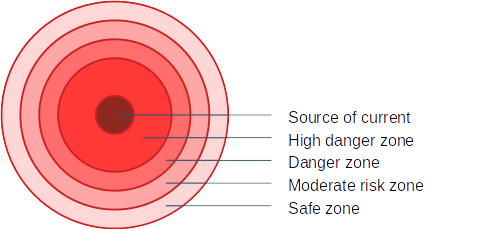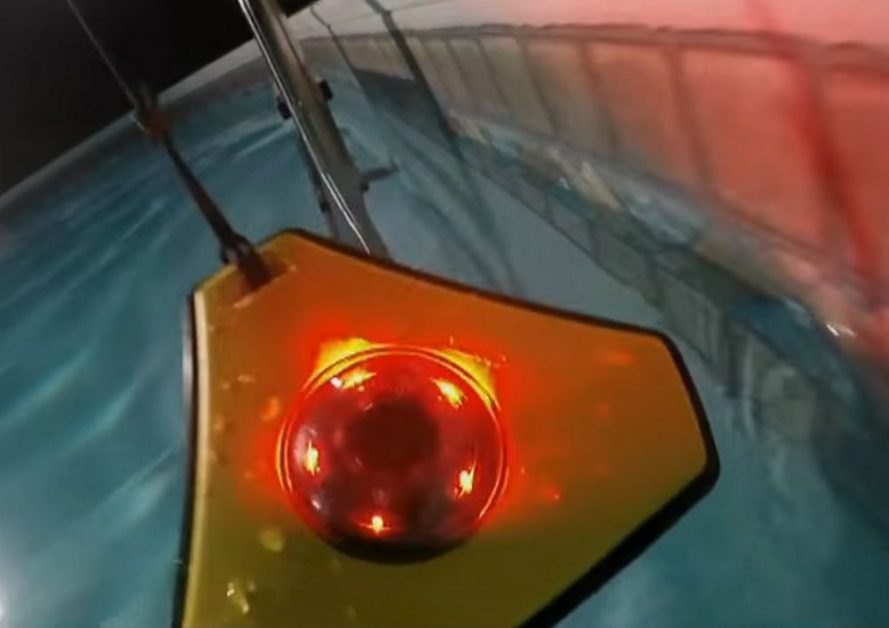How Far Does Electricity Travel in Water?

Water is commonly thought of as a good conductor of electricity because if there is live electricity inside the water, and someone touches it, they can be electrocuted.
There are two things to note which can make a difference. One is the type of water, or how much salt and other mineral content is present, and the second is the distance from the point of electrical contact. This article explains both but focuses on the second to investigate how far electricity travels in water.
We can distinguish between four zones around the point source of electricity in water (High danger, danger, moderate risk, safe). However, the exact distances from the point source are difficult to determine. They depend on several factors, particularly voltage/intensity, spread, depth, salinity, temperature, topography, and path of least resistance.
Safe distance values in water depend on the ratio of fault current to maximum safe body current (10 mA for AC, 40 mA for DC):
- If the fault AC current is 40A, the safe distance in seawater would be 0.18 m.
- If a power line is downed (on dry ground), you should stay back at least 33 feet (10 meters), about the length of a bus. In water, this distance would be much longer.
- If a live toaster falls into water, you should not be within 360 feet (110 meters) of the current source.
I will go into more detail below.
Why it Matters to Know
It matters to know how far electricity can travel in water because when there is live electricity or current underwater, any person inside or in contact with it is at risk of being electrocuted.
It would be useful to know what the safest distance is to avoid this risk. When this risk could be present in a flood situation, it is critical to have this knowledge.
Another reason to know how far electric current can spread in water is for electro-fishing, when electricity is deliberately passed through water to catch fish.
Type of Water
Pure water is a good insulator. If there was no salt or other mineral content, the risk of electrocution is minimal because the electricity would not be able to travel far inside pure water. In practice, however, even water that seems to be pure will likely have some ionic compounds in it. It is these ions that can conduct electricity.
It is not easy to obtain pure water that would not let electricity pass through it. Even distilled water condensed from steam and deionized water, as prepared in science laboratories, may contain some ions. Water is an excellent solvent for various minerals, chemicals, and other substances.
The water for which you are considering how far electricity travels will most likely not be pure. Ordinary tap water, river water, seawater, etc., will not be pure. Unlike the hypothetical or hard-to-obtain pure water, salty water is much better at conducting electricity due to its salt (NaCl) content. It allows ions to flow like how electrons flow when conducting electricity.
Distance from Point of Contact
As you might expect, the closer you are to the point of contact in water with the source of electric current, the more dangerous it would be, and the further you are, the lower the current would be. The current could be low enough not to be as dangerous a certain distance away.
The distance from the point of contact is an important consideration. In other words, we need to know how far electricity travels in water before the current is weak enough to be safe. This may be as important as knowing how far electricity travels in water altogether until the current or voltage is negligible, close to zero, or equal to zero.
We may distinguish between the following zones around the source point, from the closest to the furthest zone:
- High Danger Zone – Contact with the water inside this zone is likely fatal.
- Danger Zone – Contact with the water inside this zone can cause serious harm.
- Moderate Risk Zone – Inside this zone, you can feel sensations that there is a current in the water, but the risks are moderate or low.
- Safe zone – Inside this zone, you are far enough from the current source for the electricity to be risky.

Although we’ve defined these zones, working out the exact distances between them is not straightforward. There are several factors involved, so we can only estimate them.

Be careful! When you know where the electricity source in the water is, you should try to stay as far away from it as possible, and if you can, turn off the electricity supply.
Estimating the Risk and Safe Distance
We can estimate the risk and safe distance based on the following nine main factors:
- Voltage or Intensity – The greater the voltage (or lightning intensity), the greater the risk of electrocution.
- Spread – Electricity disperses or spreads in all directions in water, mostly on and near the surface.
- Depth – Electricity does not travel deep into the water. Even lightning only travels as far deep as approximately 20 feet before dissipating.
- Salinity – The more salt content in the water, the wider and more easily it will be electrified. Seawater floods have high salinity and low resistivity (typically ~22 Ω.cm compared to 420 kΩ.com for rainwater).
- Temperature – The warmer the water, the faster its molecules move around. Therefore, the electric current will also spread more easily in warm water.
- Topography – The topography of the area can also make a difference.
- Path – The risk of electrocution in water is high if your body becomes the path of least resistance for the current to flow. You are only relatively safe if other lower-resistance paths surround you.
- Point of contact – Different body parts have different resistivities. For example, the arm usually has lower resistivity (~160 Ω.cm) than the trunk (~415 Ω.cm).
- Trip device – The risk is greater if a trip device is not present or if it is and its reaction time is more than 20ms.
Calculation of the Safe Distance
Estimates of the safe distance can be made based on codes of practice for the safe use of electricity underwater and studies on subsea electrical engineering.
Without a suitable trip device to control AC current, if the body current is not more than 10 mA and the body route resistance is 750 ohms, the maximum safe voltage is 6-7.5V. [1] Safe distance values in water depend on the ratio of fault current to maximum safe body current (10 mA for AC, 40 mA for DC):
- If the fault AC current is 40A, the safe distance in seawater would be 0.18 m.
- If a power line is downed (on dry ground), you should stay back at least 33 feet (10 meters), about the length of a bus. [2] In water, this distance would be much longer.
- If a live toaster falls into the water, you should not be within 360 feet (110 meters) of the current source. [3]
How Can You Tell if Water is Electrified?
Besides asking how far electricity travels in water, another important related question would be knowing if the water is electrified.
Cool Fact: Sharks can detect a difference of as little as 1-volt several miles away from the source of electricity.
But how can we tell if a current is flowing at all?
If water is highly electrified, you might think you will see sparks and bolts in it. But this is not so. Unfortunately, you will see nothing, so you cannot tell by just seeing the water. Without a current testing instrument, the only way to know would be to feel it, which can be dangerous.
The only other way to know is to test the water for current.
If you have a water pool, use a shock alert device before entering it. The device lights up in red if it detects electricity in the water. However, staying as far away from the source as possible is best in an emergency situation.

References
Website Resources:
- IMCA. https://pdfcoffee.com/d045-pdf-free.html
- BCHydro. https://www.bchydro.com/safety-outages/electrical-safety/safe-distance.html
- Reddit. https://www.reddit.com/r/askscience/comments/2wb16v/how_far_can_electricity_travel_through_water/
Video References:
TODAY
